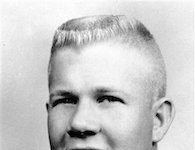On March 20, 1995, members of the Aum Shinrikyo cult released poisonous sarin gas on five Tokyo subway trains, killing 12 and injuring thousands.
Poisonous Gas Attack Kills 12
During the morning rush hour, five members of the Aum Shinrikyo apocalyptic cult boarded commuter trains headed for the center of Tokyo. Each attacker carried two or three plastic bags of liquid sarin that were wrapped in newspaper. The perpetrators set the packages down, punctured them with umbrella points, and then rushed out to waiting getaway cars.
Reports of subway injuries began at around 8:15 in the morning. Commuters piled out of trains, struggling to breathe, collapsing and bleeding from their noses and mouths.
The New York Times reported, “As trains pulled into stations, passengers staggered out onto the platforms and collapsed. Emergency workers set up tents outside subway stations, and passengers were carried out on stretchers and lay on the ground with bubbles coming from their mouths. In some cases blood poured from their noses.”
The Japanese authorities said the gas attacks affected about 15 different subway stations. “This is a case of organized and indiscriminate murder,” Masahiro Terao, a senior police official, said at a hastily called news conference.
Twelve people were killed that day and another man died the following day. The number of injured has been estimated as high as 5,000, and a recent police survey has raised the number to over 6,200 people.
The attack “showed the world just how easy it is for a small cult or group of terrorists with limited means to engage in chemical warfare,” says the Council on Foreign Relations. “It illustrated that groups not affiliated with rogue states posed a great national security risk.”
Haruki Murakami’s book “Underground” collects interviews with survivors, the victims’ relatives and the cultists responsible for the day’s terrible events.
Sources in this Story
- Council on Foreign Relations: Aum Shinrikyo
- The New York Times: Poison Gas Fills Tokyo Subway: Six Die and Hundreds Are Hurt
- Center for Defense Information: In the Spotlight: Aum Shinrikyo
- Middlebury Institute of International Studies at Monterey: Chronology of Aum Shinrikyo’s CBW Activities
- The Guardian: Cult leader to be executed for Tokyo gas attacks
- Centers for Disease Control and Prevention: Facts About Sarin
- Council on Foreign Relations: Sarin
Background: Shoko Asahara and Aum Shinrikyo
Aum Shinrikyo, meaning “Supreme Truth,” was founded in the 1980s by Matsumoto Chizuo, who became known to his followers as Shoko Asahara.
In the early ‘90s, Aum Shinrikyo began developing chemical weapons; between 1990 and 1995, it carried out 10 chemical attacks and seven biological attacks “with motivation ranging from assassination to mass murder,” according to the Monterey WMD Terrorism Database.
After the Tokyo attack, authorities cracked down on the cult. They arrested Asahara and hundreds of other leaders, seized cult property, and stripped it of its religious recognition. Asahara and about a dozen other cult members have been sentenced to death, though as of the beginning of 2017, none have been executed yet.
Japan has not outlawed the Aum Shinrikyo sect, but authorities closely monitor it. The sect, which changed its name to Aleph, formally apologized for the attack in 2000 and says that none of its current members were “directly involved in the incidents.”
The Science of Sarin Nerve Gas
According to the Centers for Disease Control and Prevention, sarin is a “human-made chemical warfare agent” that over-stimulates the muscles and organs, interfering with the nervous system. This nerve agent is a “clear, colorless, and tasteless liquid,” though it can turn into a gas. Symptoms may occur seconds after exposure. Although individuals moderately exposed to sarin are likely to fully recover, severe exposure normally leads to death.
A drop of sarin can be deadly within minutes, and it is over “500 times as toxic as cyanide,” according to the Council on Foreign Relations. The sarin used in the 1995 Japanese attacks was not particularly lethal, however, and poorly released. Saddam Hussein revealed that Iraq had 790 tons of sarin gas in 1995, and he used sarin on the Kurdish people in 1987 and 1988.
In 2012, we published this article about this historic event on the New York Times Learning Network. This article connected the event to current issues and offered reflection questions to help the reader think about its relevance today.











